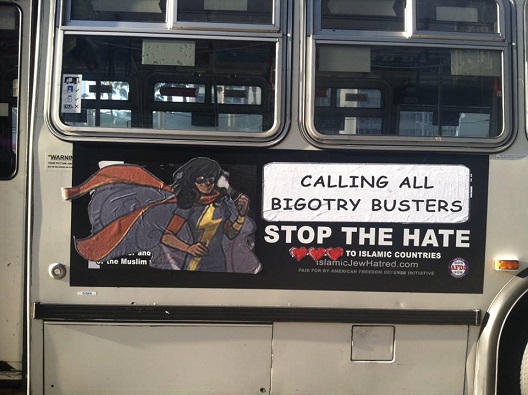
The buzz around Marvel’s new Ms. Marvel series, now a year old, from the start has been as much about what it represents as about the comic itself. Kamela Khan is after all the first American-Muslim superhero to get her own series and a decade and a half into the War on Terror this still matters. How much it matters you can see from the photo above, showing one of Pam Geller’s attempts to spread hate defaced with Kamela Khan’s likeness, spreading the opposite. If there ever was a comic designed to become part of the floating online culture wars, this was it.
And with its success and that of its Marvel stablemates, quirky titles like Hawkeye and Young Avengers, comes imitation, as DC has just announced its plans to make its line more diverse. (Which is a bit ironic, considering how much effort they put in purging it from any trace of diversity in the past five years or so…) Tom Ewing called this chasing the Tumblr audience, new, younger, more diverse comics fans lured into fandom by the movies or online culture:
It’s a question where the obvious answer is the right one – new audiences live there. Just as Tumblr is more diverse than the Internet as a whole, so comics fandom on Tumblr is more diverse than comics fandom on IGN or CBR or Newsarama. It’s younger, queerer, more racially diverse and most obviously a lot more female – and those voices lead the conversation, they don’t constantly have to fight to win a place on it. It’s also – perhaps anecdotally, perhaps not – newer to comics. I argued after the end of Young Avengers’ precursor series, Journey Into Mystery, that Marvel’s original strength was built on leapfrogging the kids to attract a new, smart, post-teenage audience back in the 60s, and that now they needed to do the same thing in reverse: leapfrog the long-term fans to win that same audience back. But that new audience looks very different now.
And if you buy into the cliche of Tumblr being all about “social justice and feels”, then Ms. Marvel fits that bill perfectly. Social justice, because in the post-9/11 political climate, even now, just having a superhero comic about a Pakistani Muslim-American is social justice, a political act. Her writer, G. Willow Wilson, is of course herself a Muslim convert, something again that many can’t help but see as a political act. Feels, because so much of the first volume at least is about Kamela and her family, what it feels like to be the only Muslim in the village so to speak, but also about her feelings about superheroes. She’s a geek, a superhero nerd whose favourite hero is Captain Marvel/Carol Danvers, which is why she takes Ms. Marvel as her own superhero name.
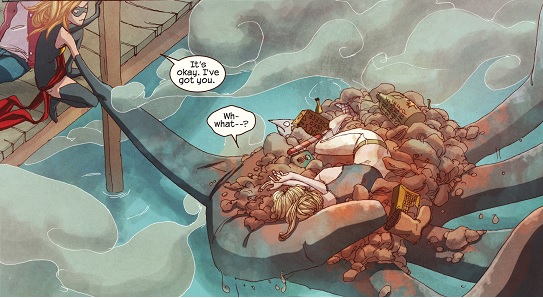
So what we have now therefore is a spinoff of what was originally herself a spinoff of a male hero, the original Marvel Captain Marvel, if not the original Captain Marvel (it’s a long story). There’s no real reason why Kamala should’ve taken this name but brand recognition, but it is sort of fitting, plays to Marvel’s seventies history of extending who can be a superhero through creating distaff counterparts of male heroes (She-Hulk, Spider-Woman, Ms Marvel etc).
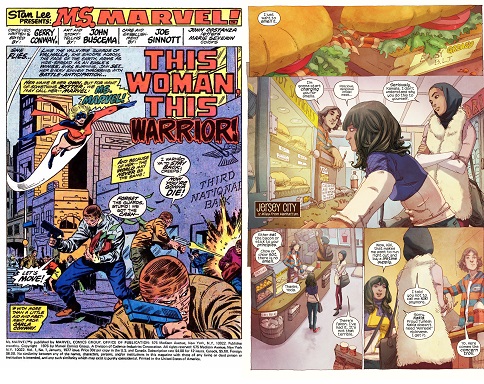
It’s interesting to compare that first Ms. Marvel series with the current one. That series started off in media res, with two of Marvel’s most dependable Bronze Age creators working on it, Gerry Conway and John Buscema. Ms Marvel flies in from the left as a robbery is in progress; there’s almost as much text here on one page as there is in any single issue of the new series. G. Willow Wilson on the other hand starts the series as mundanely as possible, at a corner store somewhere in a Jersey City neighbourhood. In this it reminds me of that other Marvel series about an misunderstood teenager becoming a superhero, but Spider-Man only needed one issue of Amazing Fantasy to have his origin, first adventure and fight his first crook. It takes Kamala five issues. This is very much a product of the decompressed era of superhero comics storytelling.
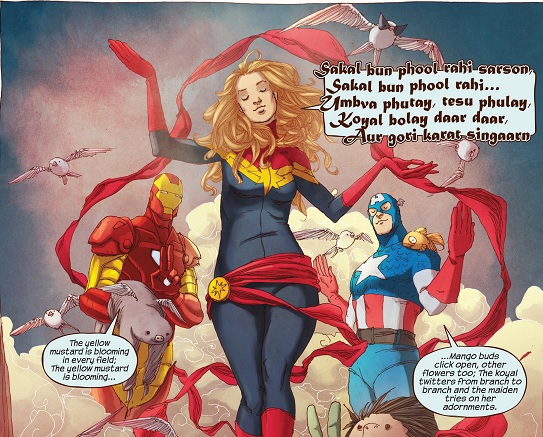
I don’t very much like decompressed storytelling or anything else that’s a cheap imitation of cinema or an attempt to make comics look more grownup, but here it works because the focus isn’t on the action, it’s on Kamala’s interaction with her family, friends and wider environment. Even the big climax of the first issue, when she gets her powers and “meets” Captain Marvel, Iron Man and Captain America, they end up talking about her family.
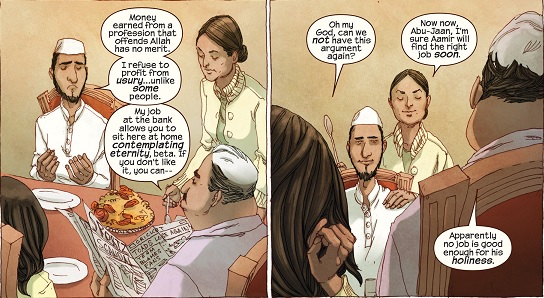
Adrian Alphona’s artwork fits the storytelling perfectly. His people are caricatures, not at all realistic, all elongated or squat in a way that codes cartoony. It gives his characters an expressiveness that even in quiet moments works well, far better than with a more “realistic” art style. It also helps with depicting Ms Marvel’s powers, all based in body deforming.

Put it all together and you have a comic that is a decent, well crafted superhero comic that puts its focus firmly on what Marvel has always done better than anybody else, showing their heroes’ complicated home lifes inbetween the battle royales. But the main significance of Ms. Marvel is who she is and that Marvel is comfortable publishing a Muslim written comic starring a Muslim superhero, that’s respectable about the culture Kamala Khan comes from and represents, but not afraid to show conflict either. It doesn’t devolve into cliches about oppression and Islam and all that while still showing a teenager chafing at the rules laid on her by authority figures — parents, teachers, religious leaders. It is essential Marvel teen hero stuff, reinvented for the 21st century.





